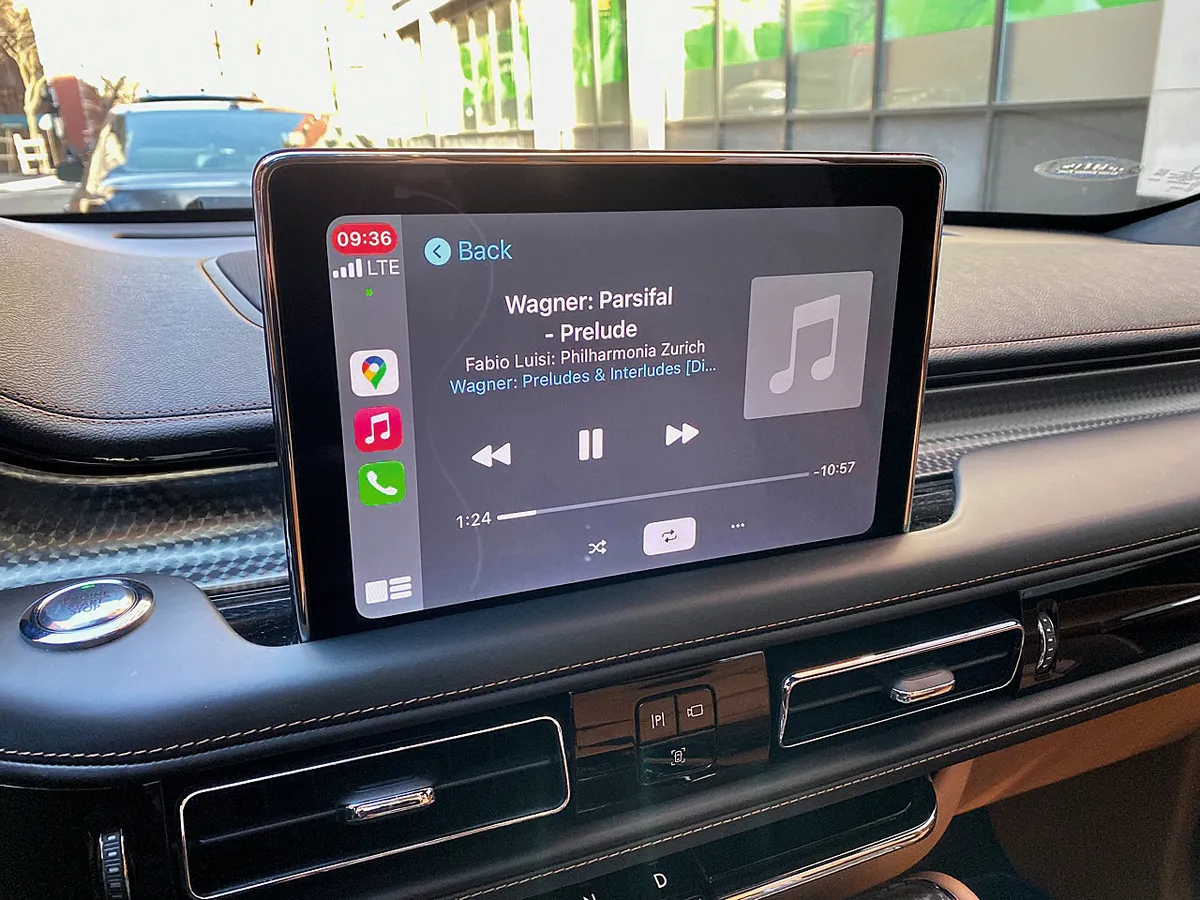Car audio was once the poor stepchild of home stereo systems. While your sofa could masquerade as a sixth-row-centre orchestra seat, your vehicle offered a utilitarian, staticky AM radio which vied with engine rumble, traffic noise and battered road surfaces.
- What is high-resolution audio and what are the best hi-res players for classical music?
- Which are the best music streaming services for classical music lovers?
- How to choose the right headphones for listening to classical music
- Creating ‘live’ sound at home with your hi-fi system: the best equipment on the market
Which cars have the best audio systems?

But lately, cars have gained theatre-worthy audio features of their own, driven by advances in noise cancellation, signal processing and a push to install more speakers in the cabin. At the high end of the market, car manufacturers have been positively cramming in those speakers: Audi offers a Bang & Olufsen 3D sound system that puts out 1,920 watts of sound through 23 speakers; Ranger Rover rocks a 28-speaker, 1,700-watt Meridian system; the Mercedes Maybach S 580 contains a Burmester 4D surround-sound system with 30 speakers and two resonators in each seat, intended to make you feel as if you’re sitting beside the bass drum in Verdi’s Requiem.
The technology is also appearing in less expensive vehicles. Volkswagen’s Passat and Arteon, for instance, both dish out 700 watts of sound through 12 Harman Kardon speakers. The compact Nissan Juke uses eight Bose speakers plus a pair of 2.5-inch speakers in each of the front-seat headrests to offer a 360-degree panorama of sound. ‘We always think of higher-end luxury cars, like Cadillac, Porsche or Infiniti, as having these robust surround sound systems,’ says Bruce Sanborn, a marketing manager at Bose Automotive. ‘But now, the consumer desire for those experiences is moving to smaller segments, and to what might be considered non-traditional segments of the market.’
Massachusetts-based Bose pioneered the customised, factory-installed sound system with the 1983 Cadillac Seville; this displaced the hitherto usual FM radio with a player for eight-track tapes or cassettes, either of which had a tendency to unravel and exasperate audiophiles with tape hiss. In response, companies such as Alpine, Sony and Pioneer stepped in with an audio aftermarket, and stereo installation shops sprang up on every corner. Car-customised systems have now become almost standard fare, with the upper echelon led by the likes of Harman Kardon, Burmester and McIntosh Labs.
To get a feel for immersive sound, BBC Music Magazine invited me to try out a 2021 Lincoln Aviator Grand Touring AWD on some of New York City’s potholed and perennially congested motorways. The plush, midsized SUV (priced at $88,335/£64,000) floats on an air-glide suspension and is equipped with a 28-speaker, 1200-watt 3D audio system designed by Revel, Harman International’s premium audio brand. Its marquee feature is QuantumLogic 3D Surround (QLS), an algorithm that analyses the audio signal, digitally separates the instruments or voices, then steers them into speakers in the surround array. Though it takes some sleuthing to locate it in the centre touchscreen display, QLS allows the driver or passenger to neatly toggle between three listening modes: a baseline stereo mode; ‘Audience’ mode, which is a bit livelier and more immersive; and ‘On Stage’ mode, which delivers a halo of sound to speakers in the headliners, doors and rear, and which is perhaps the most congenial to classical music recordings.
In Vaughan Williams’s tension-filled Fourth Symphony (admittedly a poor mood-setter for urban gridlock), the lack of distortion and unwanted boom in the bass and percussion was especially apparent. The system’s capabilities further came to life on recordings with a wide channel separation. Using ‘On Stage’ mode, Gabrieli’s antiphonal brass canzonas ricocheted from all corners of the tan leather cabin. Even more of a kick was Ennio Morricone’s theme to The Good, the Bad and the Ugly, its trumpet fanfares and ah-ee-ah-ee-ah’s seeming to echo from one of Sergio Leone’s Western panoramas.
What about car speakers?
In most vehicles, speakers are added to bring clarity to high frequencies rather than pump out more bass, says Roger Shively, managing director of research and development at JJR Acoustics, an international firm that designs and tunes audio systems for cars. ‘If you have an infinite number of loudspeakers you have control over the sound field,’ he says. ‘That can become impractical and costly, of course. But those increases usually involve overhead speakers to create a three-dimensional sound field.’
Still, a principle ascribed to computer science also applies to car audio: garbage in, garbage out. For a generation, FM broadcasters have applied dynamic range compression, a levelling effect so that the listener doesn’t have to constantly twiddle the volume in a Mahler symphony (though BBC Radio 3 makes a point of not processing its signal). Then came audio data compression, used to limit the storage requirements of audio files. Both can cut the width of a stereo image and crush high frequencies. Car audio manufacturers have developed technologies aimed at restoring musical details that have been lost through compression. Among them are Revel’s Clari-Fi and Bose’s SoundTrue, each of which acts as a kind of Photoshop for recordings.
How do new car audio systems mask road and wind noise?
When it comes to masking road or wind noise, car manufacturers have historically turned to undercoating, thicker glass or denser carpet padding. But these add weight to a vehicle, which in turn drives up petrol or battery use. So Bose has developed a number of branded technologies as alternatives. One is AudioPilot, which automatically adjusts the music volume to compensate for wind and pavement sounds. New to the market is QuietComfort road noise control, which detects vibrations on the vehicle body caused by road surfaces and then sends a cancellation signal through the car’s speakers.
The steady refinement of noise cancellation technology also makes it possible to modulate interior sounds. Harman has a feature called ClearChat, which uses microphones and audio signal processing to make it easier to isolate sounds, so that one person may conduct a hands-free phone call while others continue to enjoy music. Some engineers believe this area is ripe for development, as mics and directional speakers make it possible to isolate passengers acoustically from one another.
There’s an art and a science to tuning a car, of course. Elliott Scheiner is an eight-time Grammy Award winning producer and engineer whose credits include albums by Paul Simon, Van Morrison, BB King, Eric Clapton and the Eagles. He has also developed a second career as an auto sound designer, working with Acura, the American luxury division of Honda. His design signature can be heard in the 16-speaker, 710-watt ELS Studio 3D audio system, which was developed with Panasonic and is available in several Acura models (sold mainly in North America, Hong Kong and China).
The design process, according to Scheiner, takes into account everything from interior space to electrical power. ‘In the 2004 TL we had seven speakers. It sounded great if you were driving the car.’ But the system shortchanged the passengers, especially in the rear. ‘Eventually, we decided we need to add more speakers.’ Scheiner recalls a time when he had a car delivered to some musician clients, US rockband the Foo Fighters, expressly so they could sit in the cabin and listen to a mix of their latest recording session. It has become a part of his mixing process. ‘I wanted a car where a producer, an engineer and an artist could get in there and say, “wow this is it”,’ he says. ‘I figure the listener will eventually go with what the artist, producer and engineer want.’
With General Motors planning to go all-electric by 2035, and Volvo saying it will convert its fleet to battery power by 2030, car manufacturers are in a race to break with their fossil-fuel pasts. This, along with the promise of autonomous vehicles, should place greater focus on audio design. ‘People are going to start to pay more and more attention to the experience in the vehicle,’ says Alec DeLeon, an acoustics engineer at Revel who worked on the Aviator. ‘If it’s an electric vehicle, suddenly you’ll have a much quieter experience. Drivers will want to listen to some good music when they have a trip in front of them.’
Meanwhile, 5G connectivity is gradually making its way to cars, with plans being made by BMW, Volvo and Ford in anticipation of an industry-wide move to the speedy networks. Calling up your favorite recording or playlist from a cloud server will become much quicker. Roger Shively says that, for these reasons, car audio remains a dynamic industry. ‘The car itself has become feature-laden. Carmakers need to have what everybody else has, because that’s what sells the car now.’
What about warning sounds for silent electric cars?
Car manufacturers are increasingly creating ‘sonic signatures’ for interior chimes and as warning alerts for electric vehicles whose engines don’t produce noise on their own.
For its growing line-up of electric cars, BMW hired Oscar-winning composer Hans Zimmer to create a sound that would alert pedestrians and cyclists of the approaching vehicle. The humming, spaceship-like effect changes in pitch and volume according to the car’s speed.
The Fiat 500, meanwhile, plays an actual melody when the EV accelerates – specifically, an excerpt from Nino Rota’s Amarcord. In a demonstration video, Fiat executive Olivier François, compares it to a phone ringtone, and predicts that sound will be customisable and ‘not the voice of a computer [but] the voice of the Italian creative spirit’.
In 2018, Lincoln hired the Detroit Symphony Orchestra to record sounds for some 25 vehicle features, including the open door and unfastened seat belt alerts. One start-up chime in the Aviator features a soothing, five-note marimba pattern and a syncopated viola riff. It’s a strikingly organic alternative to the standard synthesised chime.
